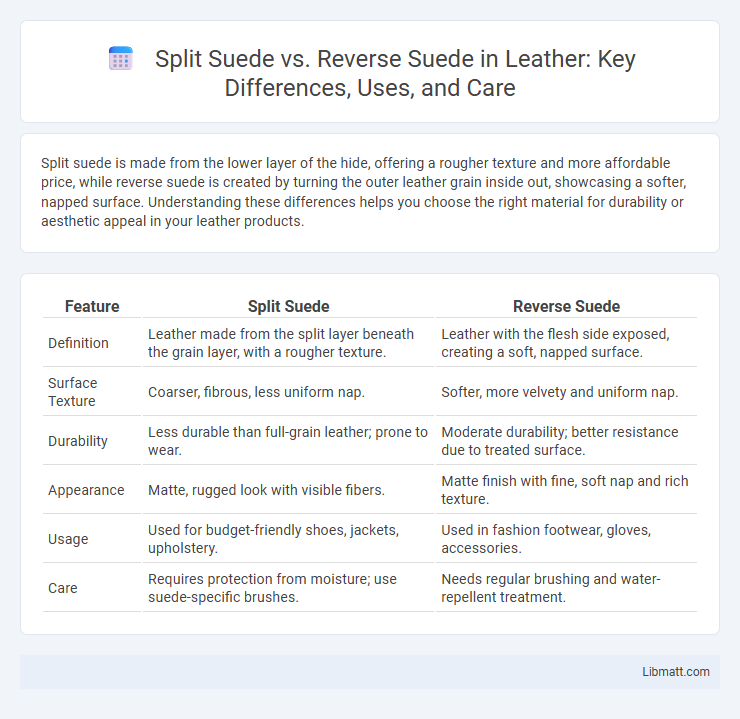Split suede is made from the lower layer of the hide, offering a rougher texture and more affordable price, while reverse suede is created by turning the outer leather grain inside out, showcasing a softer, napped surface. Understanding these differences helps you choose the right material for durability or aesthetic appeal in your leather products.
Table of Comparison
| Feature | Split Suede | Reverse Suede |
|---|---|---|
| Definition | Leather made from the split layer beneath the grain layer, with a rougher texture. | Leather with the flesh side exposed, creating a soft, napped surface. |
| Surface Texture | Coarser, fibrous, less uniform nap. | Softer, more velvety and uniform nap. |
| Durability | Less durable than full-grain leather; prone to wear. | Moderate durability; better resistance due to treated surface. |
| Appearance | Matte, rugged look with visible fibers. | Matte finish with fine, soft nap and rich texture. |
| Usage | Used for budget-friendly shoes, jackets, upholstery. | Used in fashion footwear, gloves, accessories. |
| Care | Requires protection from moisture; use suede-specific brushes. | Needs regular brushing and water-repellent treatment. |
Introduction to Split Suede and Reverse Suede
Split suede is leather created by splitting the hide into layers, revealing a soft, napped surface known for its durability and flexibility. Reverse suede, on the other hand, is made by turning the leather inside out to expose the inner side, offering a smoother texture with subtle suede characteristics. Your choice between split suede and reverse suede depends on the desired texture, appearance, and application in fashion or upholstery.
What is Split Suede?
Split suede is a type of leather created by splitting a thick hide into layers, using the fibrous underside instead of the grain surface. It features a soft, napped texture that is more porous and less durable than full-grain leather but offers excellent flexibility and breathability. This material is commonly used in footwear, gloves, and upholstery due to its distinctive appearance and tactile qualities.
What is Reverse Suede?
Reverse suede is made by turning split suede inside out, showcasing the rougher, flesh side instead of the smooth outer layer. This process highlights a textured, matte finish that offers a more rugged appearance compared to traditional split suede. Your choice between split and reverse suede depends on whether you prefer a soft, velvety feel or a more durable, tactile surface.
Key Differences Between Split Suede and Reverse Suede
Split suede is derived from the lower layer of a hide after the top grain is separated, offering a textured surface ideal for durability and resistance. Reverse suede, often called nubuck, is created by sanding the outer side of the hide to produce a soft, velvety texture with a smooth, fine nap. The primary differences lie in their texture, durability, and manufacturing process, with split suede being coarser and more robust while reverse suede provides a finer, more delicate finish.
Appearance and Texture Comparison
Split suede features a soft, velvety texture with a smooth, consistent nap, giving it a refined, polished appearance ideal for luxury garments and accessories. Reverse suede, created by turning the leather inside out, has a fuzzier, more textured surface with a rugged, matte finish that adds an authentic, casual look to your outfits. Both types offer distinct tactile sensations, with split suede feeling sleek and supple while reverse suede provides a coarser, more natural grain.
Durability and Performance
Split suede, derived from the inner layer of leather, offers moderate durability but tends to be more prone to wear and tear compared to full-grain leather. Reverse suede, also known as nubuck, is created by sanding the outer grain, providing a softer texture with enhanced resistance to abrasion and longer-lasting performance. Both materials perform well in footwear and apparel, but reverse suede typically outperforms split suede in durability due to its tougher grain structure.
Common Uses in Fashion and Footwear
Split suede is commonly used in casual footwear and outerwear due to its soft texture and affordability. Reverse suede, also known as nubuck, is favored for high-end fashion items and luxury shoes because of its smooth, velvety finish and durability. Both materials enhance design versatility in jackets, bags, and boots, offering distinct tactile experiences.
Care and Maintenance Tips
Split suede requires careful cleaning with a soft brush or a suede eraser to maintain its texture while avoiding water exposure that can cause stains. Reverse suede, also known as nubuck, benefits from regular use of a specialized suede protector spray to repel dirt and moisture effectively. Your leather care routine should include gentle brushing to keep fibers intact, preventing damage and prolonging the life of both split suede and reverse suede items.
Pros and Cons of Each Type
Split suede offers a smooth texture and higher durability due to its top-grain layer, ideal for longevity and resistance to wear, but it can be less flexible and more expensive. Reverse suede, created from the inner side of the leather hide, provides a softer, more pliable feel and a unique matte finish, though it tends to absorb dirt more easily and requires more maintenance. Your choice depends on whether you prioritize durability and classic appearance or softness and distinctive texture in leather products.
Which Suede is Right for You?
Split suede offers a soft, flexible texture ideal for casual clothing and accessories, providing durability through its fibrous inner layer. Reverse suede, often called nubuck, features a smooth, velvety finish made by sanding the outer surface of leather, lending a polished appearance suitable for dressier shoes and jackets. Your choice depends on whether you prioritize the rugged feel of split suede or the refined look and softness of reverse suede for your style needs.
Split suede vs reverse suede Infographic

 libmatt.com
libmatt.com